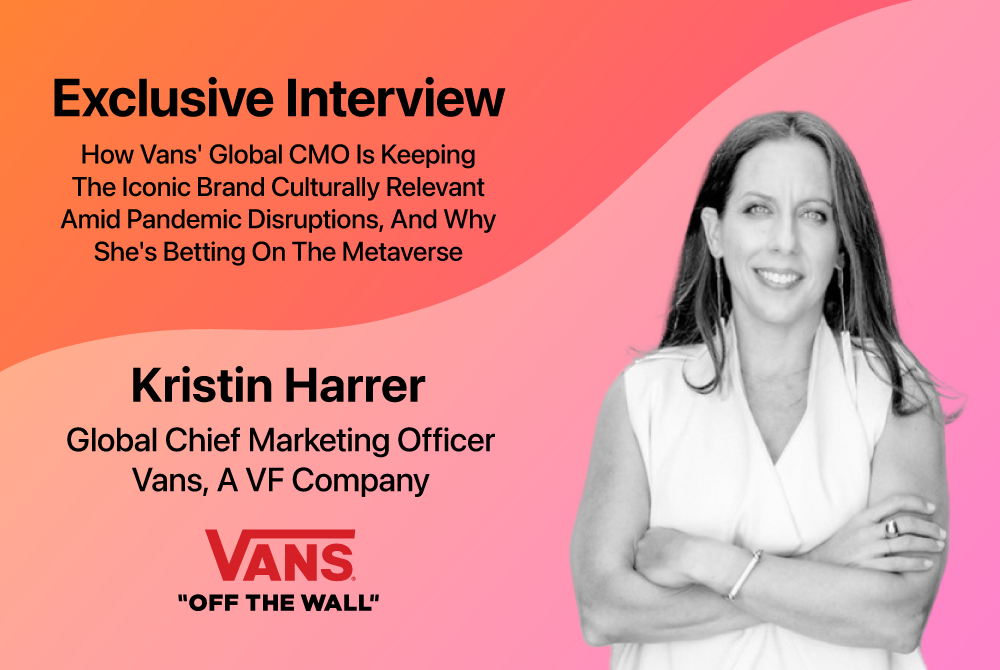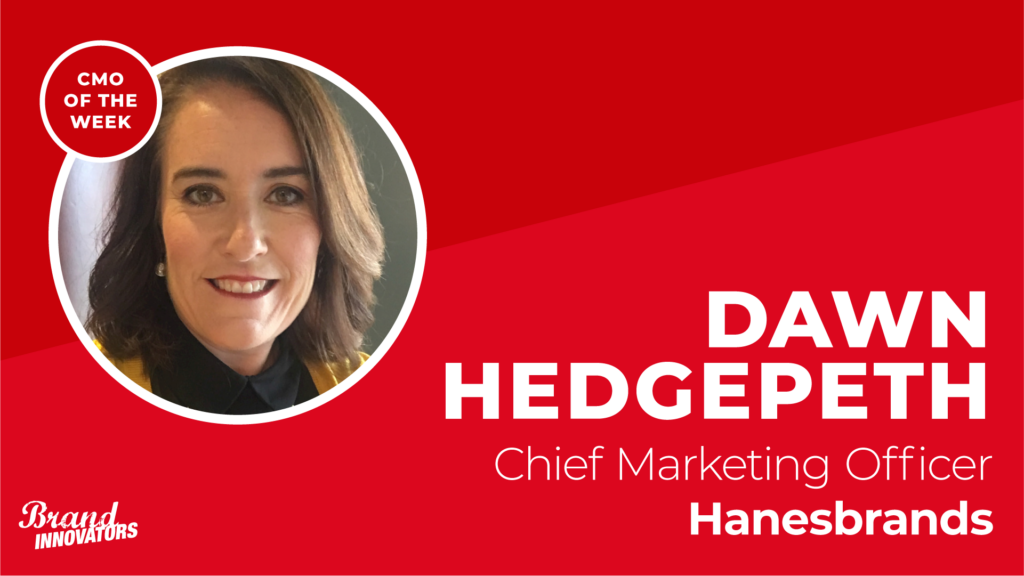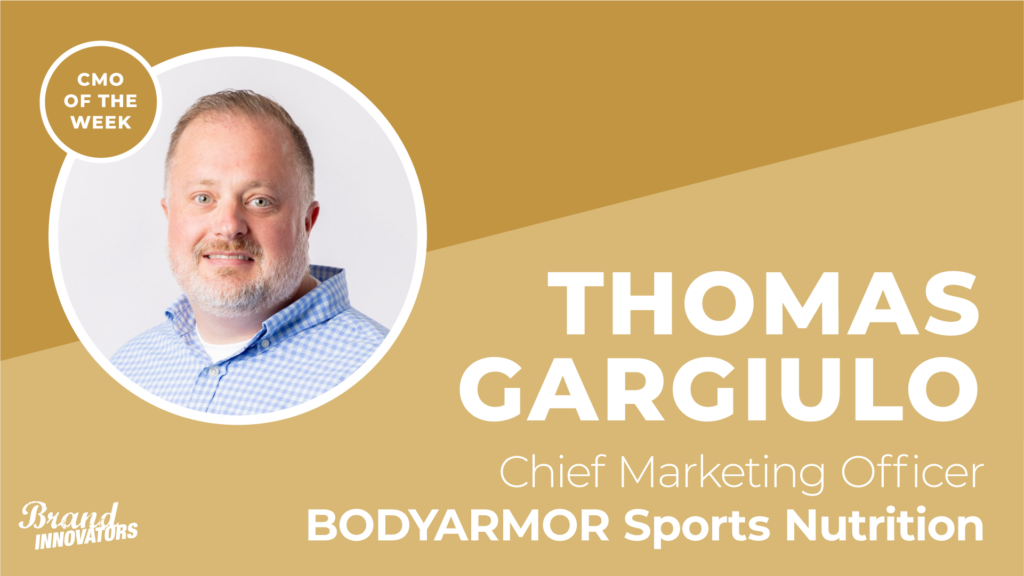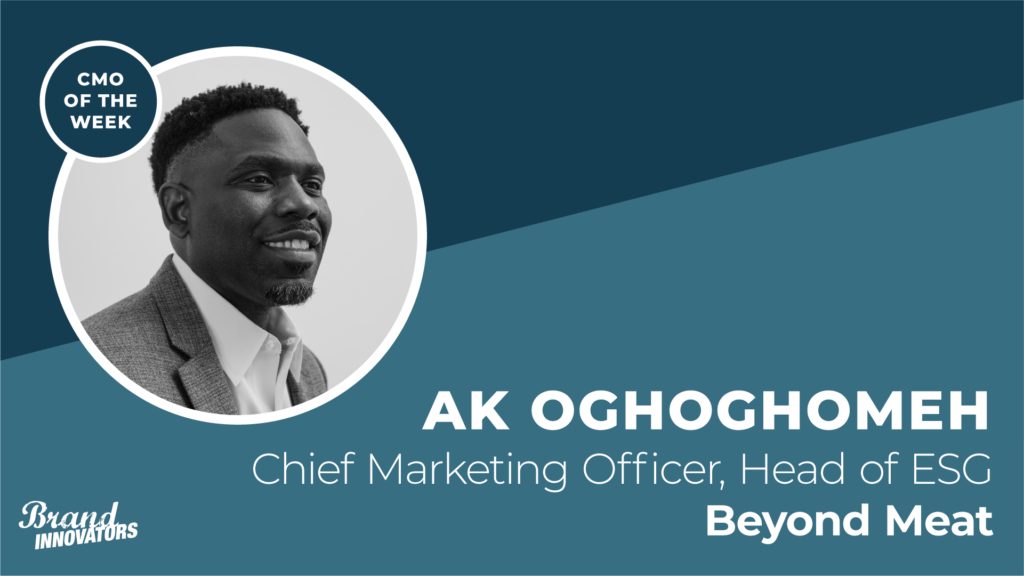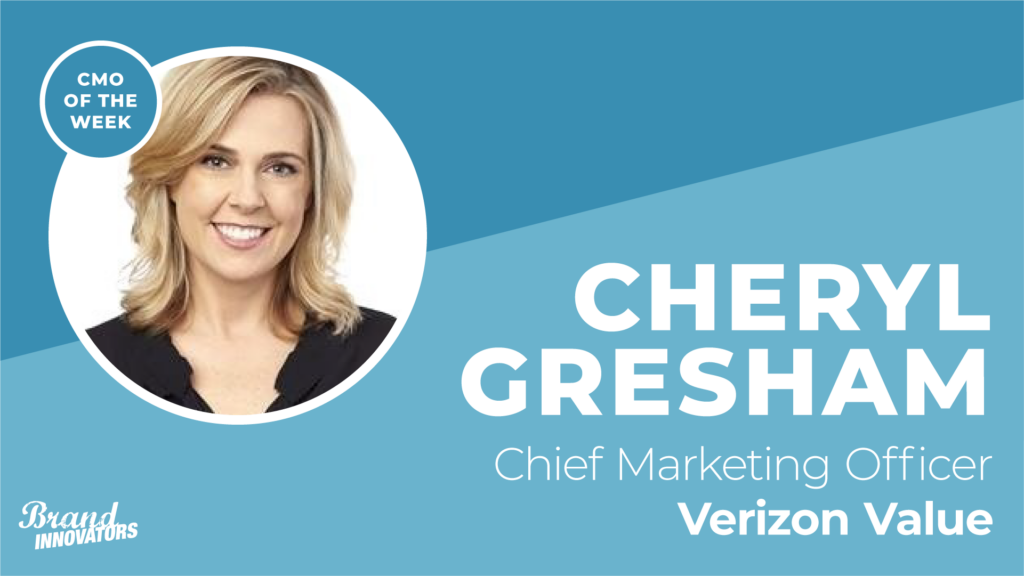When Kristin Harrer took the reins as global chief marketing officer of Vans one year into the pandemic in April 2021, her first big execution wasn’t a campaign so much as a thank-you to the creative communities who’ve helped the shoe and skate-wear brand become an icon of street culture for many decades.
“We could have taken a production budget and made a global brand campaign and pushed it out into the media,” Harrer recalls. “But we thought, so many people that love our brand are artists. And all of a sudden, so many of them are struggling. So how do we help?”
The result became “These Projects Are Ads For Creativity,” a program developed in early 2021 that Harrer helped roll out upon her arrival. “We took a lot of the budget we would have put toward a global ad campaign and gave it to 80 different creators in regions all over the world to give them a voice and a platform to show their work, and to make an emotional statement about what creativity means in a time like this. At Vans, we say being authentically yourself is hugely important, and we use the brand to champion as many of those diverse voices as possible.”
The program is just the latest in a long legacy of Vans taking on a role as more of a patron of the arts vs. a more transactional sponsor, investing in decade-plus-long programs like House of Vans that serve as both a hub for local communities and a discovery platform for emerging talent in the worlds of skate, sport, art and music culture. Vans is one of the few brands who’ve maintained and even amped up their support of emerging arts culture at a time when many of their category peers have scaled back, and Harrer sees no signs of that stopping.
“When it comes to working with celebrities and ambassadors, we’ve worked with big names but we also work with the up and comers. And that mix is what sets us apart. We’ll never go away from that,” she says. “Our mission is to empower everyone in the world to use creativity to discover themselves.”
By maintaining a dual focus on globally scalable and hyper-local cultural marketing, Vans continues to report healthy sales growth amid the continued disruption brought on by the pandemic to the apparel category. In its second quarter 2022 fiscal results, parent company VF Corp reported 7% global growth for Vans, led by 9% growth in the Americas – including a 35% increase in DTC sales. Vans also expanded its digital audience through platforms like “Channel 66,” a livestream platform launched on Vans.com and Twitch to showcase the brand’s support of music and culture. As of October 2021, “Channel 66” accumulated 2.6 million viewers from 674 broadcasts.
And that’s not the only digital playground where Vans is seeing initial success. In September, Harrer oversaw the launch of “Vans World,” a metaverse experience on the Roblox platform that showcased Vans’ apparel in a virtual setting. “Our intention from the beginning was just to create this simple, immersive experience that felt like you were there with us live, and showcase all those vectors we normally look to — creativity, connectivity, personal self-expression,” she says. As of December 2021, Vans has seen over 51 million visits to the Roblox experience, an experience rating of 94% and a total of over 6 million hours played.
Brand Innovators caught up with Harrer from her home office near Vans’ headquarters in Costa Mesa, California to learn more about her first year in the role, why she’ll continue to bet on the metaverse in 2022 and bringing Vans’ substantial commitments to DE&I and sustainability to life through marketing. The conversation has been edited for length and clarity.
Brand Innovators: You joined Vans in April 2021 as CMO. What have been some of your first priorities and initiatives since starting in the role?
It’s been great, but I don’t think I realized just how far the “family” feel of the brand goes. Our founder Paul Van Doren liked to say “Vans is really a people company that happens to make shoes.” That manifests itself in this familial feel that we call the Van Doren spirit. I entered and we’re still in the middle of a global pandemic, so I spent the first few months getting to know everybody remotely and get a feel for our culture so I could help represent that out in the world. And then pretty quickly I realized that the Vans family feeling goes way beyond our company, it also goes to the customers we serve – our loyalty program is called Vans Family for a reason. So the first initiatives that I oversaw and I’ll continue to oversee are focused on finding ways to use our brand platform to tell the stories that are important to our extended Vans family members, like “These Projects Are Ads For Creativity.”
Another example is a campaign we did in May during Mental Health Awareness Month with a few artistic members of the AAPI community who were also members of an organization in Los Angeles called Get Lit, and we asked them to write poetry about the intersection of their AAPI heritage and mental health. We made a campaign out of it called “We Will Be Louder.” I’m a sucker for work that makes you cry, and that is definitely one that made me cry. Those kinds of brand-level campaigns that really give voice to people with a story to tell and sort of a creative project to put on display for the world is where we focus, so that’s been my number-one priority.
How have you seen Vans’ role in style trends shift these past two years as a result of the pandemic and transitioning from Zoom back to IRL experiences? How have you marketed to those different phases of the pandemic?
Personal style has changed in what it means to a lot of people. But it’s also an opportunity to figure out how to express yourself in a new and different way, and show up for our consumers in different ways to say, “Hey, we have cool and comfortable basics whether you’re at school or hanging out with your friends.” It’s been really fun to continue to help people see how our product helps fit into a new definition of personal style, and that’s true in the digital and the physical space.
We have a focus on providing full head-to-toe looks for people from the top of their head all the way down to their feet, and we’ve been doing that for a number of years and now it’s even more important. And in terms of what’s taking off, we’ve always had a steady business with our classics like the tried and true silhouettes that we’re known for. What I love about that business is you can always come back and find the thing you love, but a new print, new pattern, new color – whatever you’re into in the moment. So we’ll continue to see traction there, but we’re in the business of helping people be themselves. It’s been a really fun way for people to engage in the process of self-expression, which is the role we play.
You launched a metaverse platform in September with Roblox to great initial success. Have you seen any impact yet on your retail or DTC business?
It obviously has gotten us a lot of great brand-level connectivity. We’re also seeing a lot of traction in driving conversation around style and our product as well. We’re definitely using that experience to bridge the gap between the virtual world in fashion and the role we play in our stores.
We’ve seen a lot of gravitation toward our Sk8-His and our Old Skools, as well as people picking up the checkerboard pattern and using that as a badge on their Roblox platform. And weirdly, our backpacks have taken off in the Roblox world. So we’re gonna keep playing there, I think “playing” is the right word. We’re a brand that is so obsessed with wanting to meet our consumers where they are, and we’ll continue to evolve alongside them and experiment, so stay tuned it’s gonna be fun.
Vans is one of the few brands who’ve maintained a long-term commitment to music, especially with a focus on emerging artists. Why does that continue to be an important pillar for Vans as a brand?
In terms of the focus that we’ve had for decades on music, it’s so endemic to skate culture so it’s in the fabric and history of the brand. If you think about your brand pillars as the things that help us stay focused, the filters that help us stay focused on what youth culture cares about — art, sports, music and street culture. And from a music point of view, once the pandemic started, we again started thinking how all of a sudden loads of musicians, artists, singer/songwriters all over the world suddenly had nowhere to play. We just started thinking about what we could do to help them.
Back in 2015, our Asia Pacific team launched a platform called Musicians Wanted, which is very much about finding up and coming musical talent in the Asia Pacific region. We identified that platform in 2020 and said, “Let’s make this thing a global digital platform so that everyone can access it.” What’s cool about it is you can submit your materials and it becomes a competition, but what you’re competing for is a global distribution deal so it’s very targeted to the up and comers. And you’re also competing for visibility on our playlists and the opportunity to play with some of our artists, so when we took a look at that platform and made it global, we got 20,000 submissions from musicians all over the world. This year in 2021, we got 30,000, so we just anticipate that that program is gonna keep growing and gaining momentum. And it will be interesting to see what happens when we bring it back to the physical space at House of Vans. We’ll continue to think about how we serve musicians in that way.
What does the future of House of Vans look like, knowing the challenges for experiential right now during the pandemic?
We’re never gonna go away from IRL. We just opened House Of Vans Mexico at the beginning of December. For a brand like ours that is so endemic to local communities and things like art and music and street culture, we’ll continue to do that. But what’s been awesome about not just the pandemic years but the last five years is that we’re challenging ourselves to think about how do we reinvent what we do on the ground and the magic we can create and bring that into the digital space? What we’ve done at Roblox is one example of this.
What are Vans and VF Corp’s latest commitments to DE&I, and how are those manifesting in your role as a marketer?
Before I got here to Vans and VF, the company had made a number of commitments in this space that are still very much front and center of the work we’re doing today. From a Vans perspective, we committed to having a more diverse employee base and culture. We committed to doubling our Black employee representation at headquarters by 2025, and we also committed to achieving 25% BIPOC representation at the director level and above by 2025.
From a marketing perspective, I spoke earlier about how important authenticity is to the Vans brand. We’ve done a lot to champion diverse voices through our work, we did a campaign with the LGBTQ community over Pride called “Together As Ourselves.” This past fall, during Latinx Heritage Month, we did another campaign called “So much More.” And during Black History month last year, we did a campaign called “Made Everyday.” It’s a huge part of what we’re communicating everyday from a brand perspective, but at the same time we recognize it’s important to uplift diverse voices, we also know it’s a huge responsibility and it’s important that we not just do the storytelling for a month or a day and then move on.
We’re also committed to building ongoing action that builds legacy. For example, right after I joined we launched a program with the NAACP called the “Creative Sole Scholarship,” meant to drive diversity, equity & inclusion within the footwear industry and provide monetary support for any Black student who wanted to pursue education for a career path in design or marketing. Recipients receive $5,000 a year over four years, so we’re investing $20,000 with 50 students per year, for a total investment of $1 million at the end of the program.
And beyond that, we’ve also committed to the following four things and I think we’ve reached almost all of these goals – we’re committed to having 50% BIPOC representation in our marketing materials and social channels, having 50% BIPOC artists and creators/ambassadors in our creative moving forward, having 35% BIPOC representation by 2022 for all global product collaborations, and 30% of BIPOC representation among our athlete roster by 2024. And in addition to that, we’re partnering with organizations that bring action sports to under-represented communities. So it’s about telling these stories, but also going and taking action to support them. I feel so fortunate to work for Vans and VF because we really do the work.
What are Vans’ current commitments to sustainability, and what role does that play in your messaging?
Around the time I started, we also announced some new sustainability commitments called “Tomorrow Starts Today.” And at the highest level, it’s just about reimagining the life cycle of our products so that consumers can choose Vans with confidence. Some of those commitments included eliminating single-use plastics by the end of 2021 and reducing greenhouse emissions by 30% in aggregate by 2030.
What I’ll also highlight is this isn’t a new thing for Vans. We’re a brand that’s very steeped into the culture of caring deeply about environmental issues. We’ve had two shoe recycling programs in our store for quite some time, and from a marketing point of view we’re doing things like looking at our events and trying to reduce total carbon footprints. Earth Day is a moment we celebrate every year, and we just launched a sustainable shoe collection called Vans Eco Theory. We’re doing a lot of work here on lots of different vectors, and I would say it’s an omnipresent thing that we’re all focused on — not just from a marketing perspective, and not just at Vans but VF, too.
How has your media mix shifted over the past year, and what new platforms or tech have you found success with in the past 12 months?
I think our mix was shifting before the pandemic, but regardless of what it actually looks like it’s always going to be a balance of performance and brand awareness spend. We also just did some really fun stuff with TikTok related to Vans Checkerboard Day, which is our single biggest philanthropic event where we raise a bunch of money for nonprofits who work in a creative space in local communities. We launched a TikTok challenge with them and got 11 billion views on the platform. We’re just trying to do some fun things in that space.
What are you most excited about for 2022?
More playing in the metaverse, and playing in some of those new digital platforms. Stay tuned for what’s to come over the next few years. Getting back to basics, we have a great basic footwear and apparel line that’s fun as a standalone. So trying to find ways to energize that even more is a fun one that we’re focused on.
Andrew Hampp is an entertainment marketing consultant for Brand Innovators and the founder of consultancy 1803 LLC, based in Berkeley, California.
